Mutualism: Eight examples of species that work together to get ahead
By Emily Osterloff
In nature, species will sometimes form unexpectedly close bonds and work to their mutual benefit.
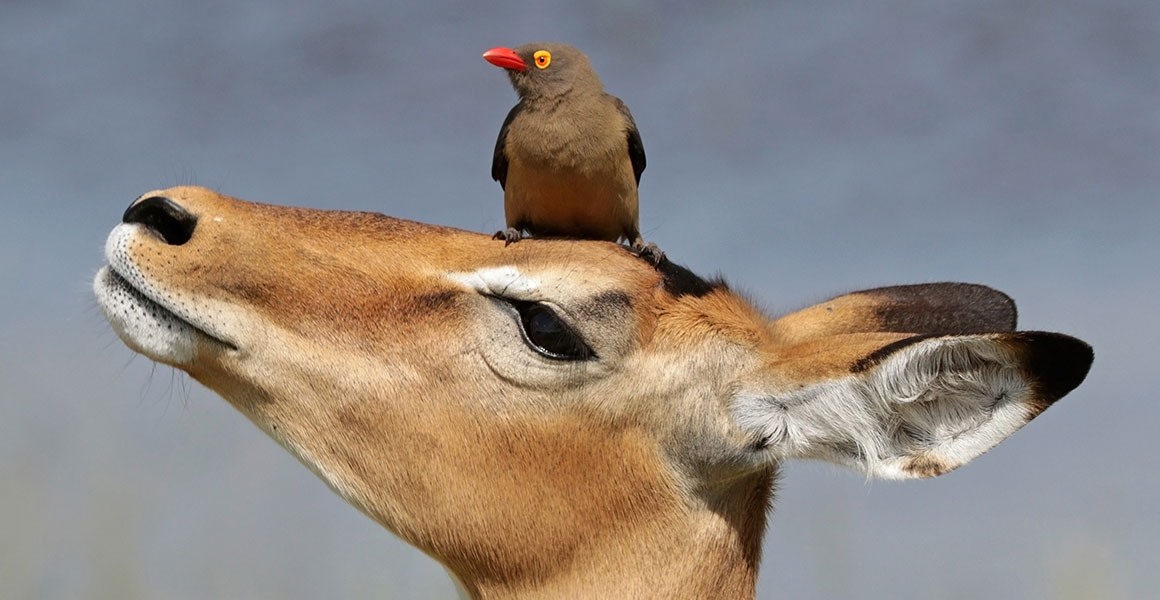
Oxpeckers regularly spend time picking parasites off the bodies of large grazing mammals. Image © Charles J. Sharpe via Wikimedia Commons, licensed under CC BY-SA 4.0
By Emily Osterloff
In nature, species will sometimes form unexpectedly close bonds and work to their mutual benefit.
Symbiotic relationships are the close associations formed between pairs of species. They come in a variety of forms, such as parasitism (where one species benefits and the other is harmed) and commensalism (where one species benefits and the other is neither harmed nor helped).
Mutualism is a type of symbiotic relationship where all species involved benefit from their interactions. While mutualism is highly complex, it can be roughly broken down into two types of relationship.
Here are eight examples of mutualistic relationships.
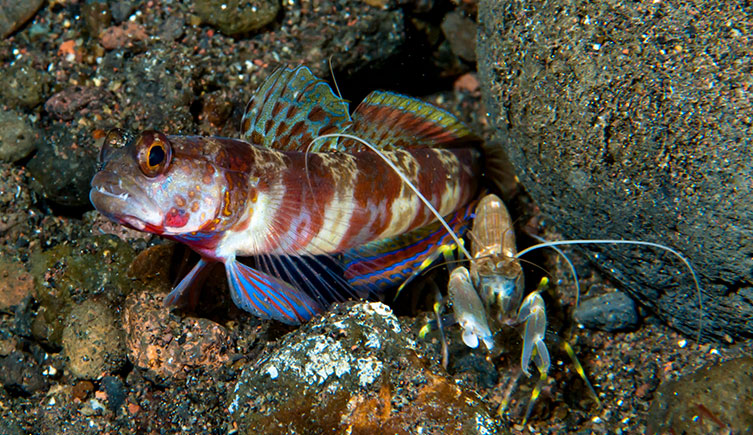
Gobies and pistol shrimps stay close together when they are outside their shared burrow © Francesco_Ricciardi/ Shutterstock
True gobies (Gobiidae) are a family of about 2,000 species of fishes. Most of them are quite small and live on the seafloor. In some cases, gobies will form mutualistic relationships with pistol shrimps of the family Alpheidae.
Pistol shrimp are burrowers, digging holes in the sandy seafloor that they will maintain and sometimes share with a goby. Outside the burrow, the pair stay close together, often with the shrimp maintaining physical contact by resting its sensitive antennae on the fish.
When the goby spots a potential predator, it uses chemical cues and bolts for cover in the shared burrow. The shrimp relies on these tactile and chemical cues to know when it needs to hide, too. When the goby is active, it signals to the shrimp that it's relatively safe to be outside the burrow.
A 2019 study showed that, as predicted by their role as lookouts, the goby - in this case the fierce shrimpgoby (Ctenogobiops feroculus) - was always first to venture outside. It seems that the shrimp's decision to leave the safety of its home only begins once its partner has exited the burrow.
The shrimps are also thought to benefit from their relationship with the fish through an increase in food, such as the fish's faeces or any parasites on its body.
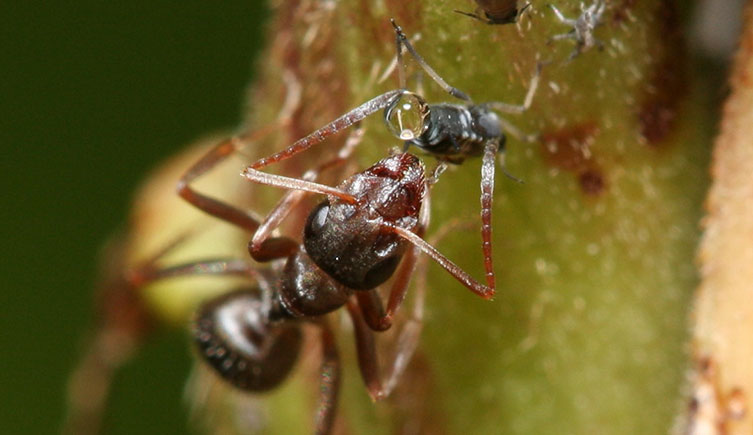
Ants feed on the honeydew produced by aphids and may offer them protection in return. Image © Jmalik at English Wikipedia via Wikimedia Commons, licensed under CC BY-SA 3.0
Aphids are little sap-sucking insects that secrete honeydew, a sugary liquid that is the waste product of their diet. Many aphid species are known to engage in a mutualistic relationship with ants that feed on the honeydew by 'milking' the aphids with their antennae.
In return, some species of ants will protect the aphids from predators and parasites. Some will move aphid eggs and nymphs underground to their nest, which ultimately makes harvesting their honeydew more efficient - like an ant equivalent of a dairy farm.
However, some aphids have evolved to take advantage of the honeydew-seeking ants. Paracletus cimiciformis aphids come in two morphs: the round morph, which is milked, and a flat, ant-mimicking morph. When the ants carry the flat individuals to their brood chamber, the aphids will drink the body fluid of the ants' larvae.
Honeydew is produced by a variety of insects, including scale insects and some caterpillars, and is appealing to species other than ants. In Madagascar, some geckos have been observed lapping up the honeydew produced by plant hoppers. This may be mutualism, with the gecko's presence keeping predators of planthoppers away, but scientists aren't sure yet.

Woolly bats are known to roost in Nepenthes hemsleyana. Image © BAZILE Vincent via Wikimedia Commons, licensed under CC BY-SA 3.0
Pitcher plants are carnivores that use nectar at the rim of their tube-like structure to attract prey such as insects and small vertebrates. A slippery substance at the rim causes these animals to fall into the digestive juices contained in the plant's equivalent of a stomach.
While you might think it would be prudent for animals to avoid these plants where possible, some bats voluntarily clamber inside them.
Woolly bats are known to roost in Nepenthes hemsleyana, a tropical pitcher plant found in Borneo.
While the bat gets a hidey-hole to rest in, the plant benefits by catching the guano (faeces) that the little mammal produces. This provides the plant with the nutrients it needs to survive.
A similar relationship occurs between tree shrews and another Bornean pitcher plant, Nepenthes lowii. The shrews climb onto the pitcher's rim to feed on the nectar. In return, with the plant's hollow body acting a bit like a toilet bowl, the shrews drop their nutritional faeces into the plant's stomach.
Find out more about carnivorous plants.
Corals may look like rocks or plants, but they are actually marine animals. The bright colours of reef-building corals come from the zooxanthellae algae they have a mutualistic relationship with.
Coral starts life as a tiny, free-swimming larva which eventually fixes itself to a hard surface and metamorphoses into a polyp. The polyp replicates and expands to form a colony by producing many identical polyps, growing one on top of each other and secreting a hardened skeleton around themselves.
As corals grow, they acquire zooxanthellae from their surrounding environment. The coral provides shelter and essential nutrients for the zooxanthellae to use during photosynthesis, while the zooxanthellae produce synthetised sugars, which the coral feeds on, and oxygen as a by-product.
Pollution and heat stress can cause corals to expel their algae which turns the coral ghostly white - this is known as coral bleaching. Going too long without algae can be fatal to the coral, as it usually cannot grab enough food particles from its surroundings to fulfil its energy demand.
Discover why coral reefs are so important.

Oxpeckers feed on parasites, such as ticks and blood-sucking flies. © AndreAnita/ Shutterstock
There are two species of oxpecker: the red-billed oxpecker (Buphagus erythrorhynchus) and yellow-billed oxpecker (Buphagus africanus). Both regularly spend time clinging to large grazing mammals such as wildebeest, rhinos and zebras.
The birds pick at parasites on the mammal's body, including ticks and blood-sucking flies. This may help keep the mammal's parasite load under control, and the birds get an easy meal.
Like a number of other species, oxpeckers will raise the alarm and warn their hosts of impending danger. People have observed that the birds will help hosts such as rhinos (which are short-sighted) evade humans.
However, mammals and oxpeckers may not be a perfect example of mutualism, as the birds can harm their hosts. The birds remove parasites and seem to prefer hosts with large numbers of them, but they will also dig into wounds. While the mammals appear relatively tolerant of this behaviour, it's not beneficial to them.
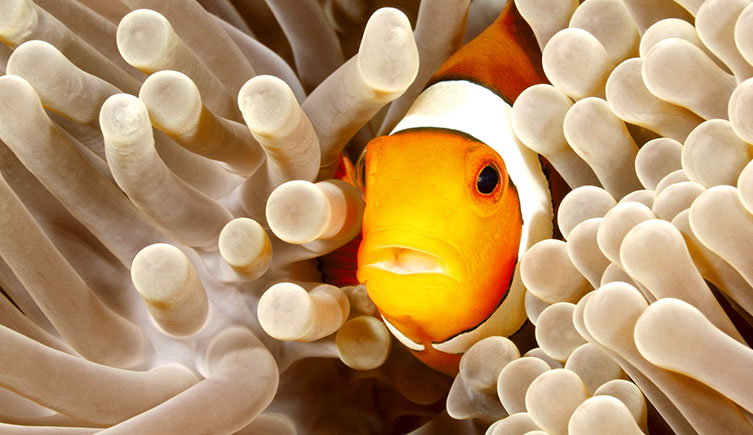
It's thought that mucus plays a role in protecting a clownfish from an anemone's sting © cbpix/Shutterstock
Anemones are flowerlike marine animals with neurotoxin filled stinging tentacles. They use these to help them subdue their prey, which are mostly plankton, crabs and fish, though larger species take larger prey such as starfish and jellyfish.
Anemones associate with many fish species, but they are particularly close with one group. Clownfish, also known as anemonefish, are immune to anemone stings, though scientists aren't exactly sure how. It's thought that the layer of mucus on the fish's body is involved in protecting them. This means clownfish can safely nestle into the anemone's tentacles to hide from predators.
In return, clownfish help the anemone in multiple ways. They keep the anemones free of parasites and provide them with nutrients through their faeces, which may also stimulate the growth-beneficial symbiotic algae within the anemone. Clownfish may also drop food onto the anemone and also drive off anemone-eating intruders that stray too close. It's also thought that the movement of clownfish helps to circulate the water, and in turn helps to oxygenate the anemone. It's possible that the bright colours of clownfish also helps to lure meals of small animals to within reach of the anemone.
Anemones that harbour clownfish appear to have faster growth rates, higher rates of asexual reproduction and lower mortality than those without fish.

Greater honeyguides and humans have a relationship that strecthes back through many generations. Image © Dominic Sherony via Flickr, licensed under CC BY-SA 2.0
The eggs, larvae and beeswax contained in bee nests are a key food source for greater honeyguides (Indicator indicator). One of the ways these birds gain easy access to a nutritious meal is by leading other honey-coveting species to the nest and allowing them to do the hard work of breaking into it.
The human-honeyguide relationship is the best-documented of these partnerships. The wild honeyguides recruit people with a demanding call, indicating that they have found a bee nest. The honey-hunting humans reply with calls passed down through generations and follow the bird.
When they reach the nest, the humans subdue the bees, such as with smoke, break into the nest and help themselves to the sugar-rich honey contained within. The Hadza people of Tanzania are one group known to work with honeyguides. It has been estimated that up to 10% of their diet is acquired with the help of the birds.
With the bees dispatched and the humans satisfied, the honeyguides are left to dine on the beeswax, eggs and larvae left behind.
When the sun sets on North America's Sonoran Desert, the night-blooming flowers of senita cacti (Lophocereus schottii) are visited by tiny senita moths (Upiga virescens).
The female moths collect pollen on specialised abdominal scales and transfer it from flower to flower, pollinating cacti as she goes. The senita moth is the only nocturnal pollinator of this cactus and is responsible for 75-95% of its pollination. The rest is attributed to other insects that are active during the day.
During her visits, the female moth will lay one egg on a flower petal. When the flower closes and the larva hatches, it will bore into the top of the developing fruit, spending about six days feeding on the seeds and fruit tissue.
The moth larvae don't eat all the seeds or fruit - it's been found that they only destroy about 21% of the developing fruit, which means the cactus can continue to prosper.
There are several similar mutualistic relationships, such as yuccas and yucca moths, figs and fig wasps, and Phyllanthaceae and Epicephala moths. Senita moths differ from these in that although the relationship is highly specialised, they are not the sole pollinator of their host plant, yet their relationship with the cactus clearly plays an important role in the cactus's survival.
Wasp expert Dr Gavin Broad explains the relationship between figs and fig wasps. Watch this video with audio description (2 minutes 11 seconds).
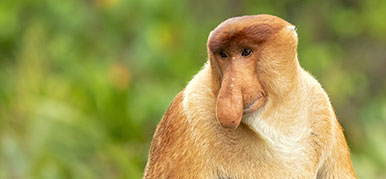
Just how weird can the natural world be?
Don't miss a thing
Receive email updates about our news, science, exhibitions, events, products, services and fundraising activities. We may occasionally include third-party content from our corporate partners and other museums. We will not share your personal details with these third parties. You must be over the age of 13. Privacy notice.
Follow us on social media